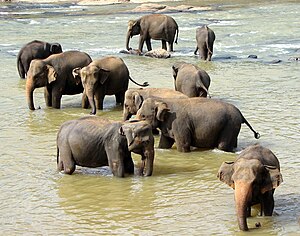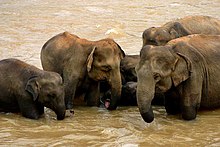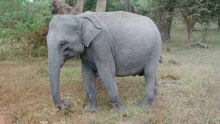Sri Lankan Elephant
| Sri Lankan Elephant | ||||||||||||
|---|---|---|---|---|---|---|---|---|---|---|---|---|

Elephants at the Pinnawala Elephant Orphanage |
||||||||||||
| Systematics | ||||||||||||
|
||||||||||||
| Scientific name | ||||||||||||
| Elephas maximus maximus | ||||||||||||
| Linnaeus , 1758 |
The Sri Lankan elephant , also Ceylon elephant ( Elephas maximus maximus ), is one of the three known subspecies of the Asian elephant and is native to Sri Lanka . Since 1986 applies Elephas maximus by the IUCN as endangered strong because the population over the last three generations, that in the last 60 to 75 years, has dropped by at least 50%. The species is severely threatened by habitat loss, degradation and fragmentation .
The Elephas maximus maximus is a subspecies of the Asian elephant, which was first described in 1758 by Carl von Linné under the binominal Elephas maximus .
The elephant population is now largely restricted to the dry zone in the north, east and south-east of Sri Lanka. The elephants live in Udawalawe National Park , Yala National Park , Lunugamvehera National Park , Wilpattu National Park and Minneriya National Park , but also outside of protected areas. It is estimated that Sri Lanka has the highest density of elephants in Asia. The conflict between humans and elephants is increasing due to the conversion of elephant habitats to settlements and permanent cultivation.
features

In general, Asian elephants are smaller than African and have the highest point on the head. The tip of the trunk is similar to a grasping finger and its back is arched or flat. Females are usually smaller than males and have short or no tusks .
Sri Lankan elephants are the largest subspecies. They reach a shoulder height of 2 to 3.5 m, a weight of 2,000 to 5,500 kg and have 19 pairs of ribs. Their skin color is darker than that of the Indian elephant and that of the Sumatran elephant with larger and more pronounced depigmented spots on the ears, face, trunk and stomach.
Only 7% of males have tusks. According to the 2011 elephant census conducted by the Wildlife Conservation Department of Sri Lanka, only 2% of the total population have tusks.
Elephants from Sri Lanka are quite small compared to the historical depiction from 200 BC. And with photographs from the 19th century during the colonial British rule over the island. The smaller size could possibly be the end result of a continuous process in which the best specimens of a potential breeding population were taken out by hunting or taming (see island dwarfing ).
Distribution and habitat
Elephants are largely confined to the lowlands in the arid zone, where they are still fairly widespread in the north, south, east, north-west, central-north, and south-east of Sri Lanka. A small, leftover population lives in the Peak Wilderness Sanctuary . It is far from the country's wetland zone. Apart from Wilpattu and the Ruhuna National Park , all other protected areas are smaller than 1,000 km². Many areas are smaller than 50 km² and therefore not large enough to contain the everyday habitat the elephants need. In the Mahaweli Development Zone , areas such as Wasgomuwa National Park , Flood Plains National Park , Somawathiya National Park and Trikonamadu Nature Reserve have been linked to create a total area of 1,172 km² as a habitat for the elephants. Nonetheless, approximately 65% of the elephant's range extends outside of the protected areas.
Former distribution area
In the historical past, elephants were common. From sea level to the highest mountain. They occurred in dry zones, in the lowland wet zone as well as in damp, cold, montane forests. During the colonial period from 1505 to 1948, the wetland was converted into a commercial field and heavily populated. By 1830, elephants were in abundance, so their extermination was promoted by the government and rewards were given out for every elephant killed. In the first half of the 19th century, forests in the montane zone were extensively cleared in order to grow coffee and then tea. The elephant population in the mountains has been wiped out. During the British rule, many bull elephants were killed by trophy hunters. One of the army majors was awarded for having shot over 1,500 elephants and two others allegedly shot half again each. Many other athletes shot between 200 and 300 animals during this time. Between 1829 and 1855 alone, more than 6,000 elephants were caught and shot.
Until the turn of the 20th century, elephants were still spread over much of the island. The currently known as Ruhuna National Park area was the Resident Sportsmen's Shooting Reserve , an area reserved for the sporting pleasure of British citizens in the country. In the early 20th century, huge reservoirs were built in the dry zone for irrigated agriculture. Earlier irrigation systems have been rehabilitated and people have been relocated again. The development picked up again after independence in 1948. As a result, the elephant habitat in the dry zone was severely fragmented.
Population development
The sizes of the wild elephant populations in Sri Lanka have been estimated at
- 12,000 to 14,000 in the early 19th century;
- 10,000 in the early 20th century;
- 7,000 to 8,000 around 1920;
- 1,745 to 2,455 individuals in 1969;
- 2,500 to 3,435 in 1987;
- 1,967 in June 1993 which were split into five regions;
- 3,150 to 4,400 in 2000;
- 3,150 in 2006;
- 2,900 to 3,000 in 2007;
- 5,879 in 2011, based on counts of elephants at watering holes in the dry season
Ecology and behavior

Elephants are classified as large herbivores and consume up to 150 kg of plants per day. As generalists, they eat a wide variety of food crops. In the north-western region of Sri Lanka, the feeding behavior of elephants was observed between January 1998 and December 1999. The elephants ate a total of 116 species of plants belonging to 35 families and containing 27 species of useful plants. More than half of the plants were not tree species, such as bushes, herbs, grass or climbing plants. More than 25% of the plant species belong to the legume family and 19% of the plant species to the sweet grass family . The fact that elephant droppings contain useful plants is not just a result of the harvest being plundered. It was also observed that elephants in the shifting eat leftover crops.
Food resources are abundant in regenerating forests but are of low density in older forests. Traditional slash and burn creates an optimal habitat for elephants by promoting the following vegetation.
Threats
During the armed conflict in Sri Lanka, elephants were mutilated or killed by land mines . Between 1990 and 1994, a total of 261 elephants died either as a result of gunshot wounds or they were killed by poachers and landmines.
Given the rarity of tusks, poaching for ivory is not the main threat today . But even so, there is still ivory trade. Kandy has been identified as the center for such illegal trade. The greatest threat to elephants, however, comes from the ever increasing human population and their demand for land. At present the significant loss of the elephant range due to economic progress is continuing and so a number of irrigation and development projects are leading to the conversion of further elephant areas into irrigated agricultural and settlement areas.
Almost 100 wild elephants were killed each year from 1999 to late 2006. They are killed to protect crops and homes. Other threats are poaching, deforestation, drought and food shortages. During the drought, many elephants destroyed the agricultural land for food. Almost 80 elephants were killed in northwest Sri Lanka, 50 in the south and east and another 30 in other parts of the country. There were a total of 160 dead elephants in 2006 alone.
protection

Elephas maximus is listed in the Washington Convention on the Protection of Species ( CITES for short ).
The Department of Wildlife Conservation's elephant conservation strategy aims to preserve as many viable populations as possible in as wide a range of suitable areas as possible. This means promoting the protection of elephants both in the system of protected zones and outside these areas for as many animals as the land can feed and the landowners can tolerate. The elephants should be restricted to the network of protection zones.
- In the Pinnawala Elephant Orphanage in Kegalle injured elephants are treated and orphan elephant calves are looked after. Almost 70 elephants live here. Breeding in captivity continues.
- The Udawalawe Elephant Transit Center in Udawalawe National Park is a rehabilitation center where orphan elephant calves are kept until they can be released into the wild.
Cultural representation

Elephants were a common element in Sinhala heraldry for over 2000 years and remained so during British colonial rule. The coat of arms and flag of the government of the British colony of Ceylon from 1875 to 1948 depicted an elephant and even today many institutions in Sri Lanka use the Sri Lankan elephant in their coats of arms and insignia .
For more than two thousand years, an important cultural symbiosis existed between elephants and humans - no religious procession was complete without the participation of elephants, and many large Buddhist temples in Sri Lanka had their own elephants.
See also
Individual evidence
- ↑ a b Elephas maximus (Asian Elephant, Indian Elephant). In: www.iucnredlist.org. Retrieved April 6, 2016 .
- ↑ Caroli Linnaei… Systema naturae: per regna tria naturae: secundum classes, ordines, genera, species, cum characteribus, differentiis, synonymis, locis. In: www.archive.org. Retrieved April 6, 2016 .
- ↑ a b Fernando, P., Jayewardene, J. Prasad, T., Hendavitharana, W. Pastorini, J. (2011). Current Status of Asian Elephants in Sri Lanka . Gajah 35: 93-103.
- ↑ Shoshani, J., Eisenberg, JF (1982) Elephas maximus . Mammalian Species 182: 1-8
- ↑ Murray E. Fowler and Susan K. Mikota: Biology, Medicine, and Surgery of Elephants . Wiley-Blackwell, 2006, ISBN 0-8138-0676-3 , pp. 3-14 .
- ↑ a b Jayewardene, J. (1994). The elephant in Sri Lanka . Wildlife Heritage Trust of Sri Lanka, Colombo
- ↑ a b c d e f Santiapillai, C., Fernando, P., Gunewardene, M. (2006) A strategy for the conservation of the Asian elephant in Sri Lanka . Gajah: Journal of the IUCN / SSC Asian Elephant Specialist Group. Number 25: 91-102
- ^ J. Jayewardene: Elephants in Sri Lankan History and Culture . Living Heritage Trust. 2012. Retrieved August 2, 2012.
- ↑ Sukumar, R. (1993). The Asian Elephant: Ecology and Management Second edition. Cambridge University Press. ISBN 052143758X
- ↑ Katugaha, HIE (1997). Tuskers of Ruhuna National Park, Sri Lanka . Gajah: Journal of the IUCN / SSC Asian Elephant Specialist Group. Number 18: 67-68
- ↑ Fernando, P. (2006). Elephant conservation in Sri Lanka: Integrating scientific information to guide policy . In: Groom, MJ, Meffe, GK, Carroll, CR (Eds.) Principles of Conservation Biology . Sinauer Associates, Sunderland, USA. Pages 649-652.
- ^ Elephants in Sri Lanka . Retrieved August 29, 2015.
- ↑ Wanigasundara, M. (1991). Sri Lanka - Elephants slaughtered in civil war . Gajah: Journal of the IUCN / SSC Asian Elephant Specialist Group. Number 6: 16-17
- ↑ a b Kotagama, S. (1991). Sri Lanka - Enhancing the survival of elephants . Gajah: Journal of the IUCN / SSC Asian Elephant Specialist Group. Number 6:24
- ↑ Hendavitharana, W., Dissanayake, S., de Silva, M., Santiapillai, C. (1994). The Survey of elephants in Sri Lanka . Gajah: Journal of the IUCN / SSC Asian Elephant Specialist Group. Number 12: 1-30
- ↑ Kemf, E., Santiapillai, C. (2000). Asian elephants in the wild . A WWF species status report. WWF, Gland, Switzerland.
- ↑ Samansiri, KAP, Weerakoon, DK (2007). Feeding Behavior of Asian Elephants in the Northwestern Region of Sri Lanka . Gajah: Journal of the IUCN / SSC Asian Elephant Specialist Group. Number 2: 27-34.
- ↑ Alahakoon, J., Santiapillai, C. (1997). Elephants: Unwitting victims in Sri Lanka's civil war . Gajah: Journal of the IUCN / SSC Asian Elephant Specialist Group. Number 18: 63-65



